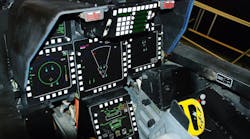U.S. Air Force officials needed technology upgrades for the Unmanned Threat Emitter (UMTE) system at Nellis Air Force Base, Nev. They found their solution from the DRS Technologies Electronic Warfare and Network Systems unit in Buffalo, N.Y.
The UMTE is for mission rehearsal ranges where combat aircraft pilots can practice their tactics before encountering the real threat in actual combat. A radiated power system remotely operated with high-fidelity signal representation provides radar-warning receiver ranging for realistic tactical training for combat air crews.
The modernization program provides enhancements to the threat reactivity model to include aircraft maneuvers and deployment of chaff. The electronic attack receivers that analyze aircraft electronic jamming enable the threat to react accordingly and help teach pilots how to survive in combat.
DRS will do the work under terms of a $27.5 million contract from the Ogden Air Logistics Center at Hill Air Force Base, Utah.
This contract is a follow-on award based on work DRS completed that included upgrades of the UMTE equipment at Eielson Air Force Base, Alaska, and new UMTE equipment installed at the Barry Goldwater Range in Arizona.
As part of the new contract, DRS will install four UMTE modification kits with refurbished hardware, system software upgrades, and range integration. The upgraded UMTE is part of the AN/TPT-T1(V) Electronic Warfare Training Set and will be able to be installed on a trailer for increased mobility.
“The new upgrades for the legacy platforms will offer unprecedented mobility on U.S. Air Force training ranges,” says Richard Danforth, president of the company’s Command, Control, and Communications strategic business unit. “The mobile, lightweight system can be lifted by helicopter or moved by commercial truck to remote locations.
“This upgrade will allow U.S. Air Force pilots to conduct realistic, time-sensitive target training and provide Nellis Air Force Base’s range manager excellent flexibility to identify and adapt the electronic warfare threats of an adversary during training scenarios,” Danforth says.
The upgrade will increase the program’s reliability and decrease operations and maintenance costs. Additionally, the UMTE also will provide a detailed post-mission analysis for pilots to assess their performance during training and learn from their mistakes, in order to improve their defensive flying techniques.
For more information contact DRS online at www.drs.com.


